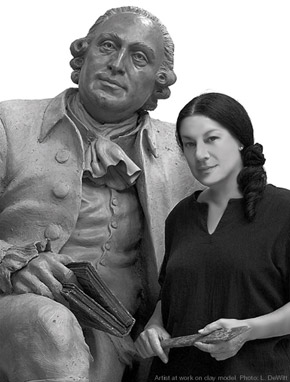 A Five-Minute Interview: Wendy M. Ross, Creator of the George Mason Statue
A Five-Minute Interview: Wendy M. Ross, Creator of the George Mason Statue
By Colleen Kearney Rich, MFA ’95
Sculptor Wendy M. Ross has more than 25 years’ experience working with developers, architects, and individual clients to create both public and private works of art. She maintains a sculpture studio in Bethesda, Maryland, and her work ranges from small scale to monumental. She received an MFA from the Rhode Island School of Design and a BA from the University of Wisconsin.
Very few images of George Mason exist. How did you decide how to depict him?
It was quite a challenge to create a believable interpretation of George Mason. No authentic visual materials exist on his likeness; the only known portrait from life was destroyed by fire. All that remains today is an “artist’s interpretation” painted 19 years after his death that currently hangs at the Mason home in Gunston Hall. When I began my research in reconstructing a likeness, it led me to some interesting places.
Early on, I was invited to an annual dinner of the George Mason Memorial Society in Richmond. The event provided an opportunity to observe the facial features of some 21 direct lineal descendents where I noticed similarities in bone structure and expression. Further research led me to rely on fragments of information in the writings of his fourth son, John, recollecting his father’s daily life at Gunston Hall. In the archives at Gunston, I examined the construction and textures of Mason’s actual clothing and his wigs to recreate those details in the bronze work.
In the course of reading historical biographies on Mason, I discovered he had recurring bouts with gout, which affected his mobility and made him reluctant to travel long distances. In the standing figure, I positioned his right hand to rest gently but supportively atop a stack of books on his desk. He is leaning slightly forward, and his right leg is slightly bowed as if not capable of supporting his full weight unaided.
I also knew Mason was largely self-taught and a voracious reader who relied heavily on the philosophy of the Enlightenment, as well as classical literature for his political views, so I chose texts that were in his library—Locke, Hume, and Rousseau. I drew from many sources, including the Smithsonian’s 18th-century furniture department to find out what types of claw feet were typical of the writing tables of that period (the feet were missing on his original writing table in his study at Gunston Hall). Don McAndrew, a volunteer who portrays George Mason at Gunston Hall, was kind enough to come to my studio in period dress on several occasions to pose for me. It helped me understand how Mason’s actual clothing draped on a human figure. Normally, I don’t use models for creating portraits because it tends to be distracting. I usually rely on photographs, which, obviously, was not an option for this subject.
The statue has come to mean so much to this campus. The students decorate it. Families take pictures in front of it. How does it feel to have created a piece of art that is endeared to so many and see its photo everywhere?
I love hearing that! After visiting and lecturing at numerous universities, it has become evident to me what is meaningful public work and what is mere decoration. In the case of the Mason piece, it’s not only a campus symbol, it has become lovingly embraced by the university community.
Does it bother you when students dress him up?
No. The work is the university’s namesake. It is a public work and meant to be part of the life of that community. I see no reason why he shouldn’t join in on the campus festivities. He is, after all, a major player.

